The French Londoner Jean Jullien is conquering Instagram with drawings that comment on life inventively, movingly, and sometimes with deadpan humour. On paper, in books, on furniture or clothes… At Encore, he is exchanging his big, funny faces for a passion project as sweet as Proust’s madeleine.
A day in the life of…anyone who sometimes bungles through existence is how you might describe the drawings that Jean Jullien posts on his Instagram account. From the innumerable attempts of the chain-smoker to stop to the tightrope walk of all those little heroes towards the end of the week, from the hole in a sock to the vortex of social media, and from Friday’s search for clean clothes to the commuter’s daydream of total freedom. The Frenchman, who swapped the Brittany of his youth for London some time ago, absorbs all of these everyday concerns with greedy eyes and digests them in such an inventive way that as an accomplice, you cannot suppress a smile.
Jean Jullien’s work strikes a sensitive chord – among more than one million Instagram followers. And that is not only because we are all bunglers. His little observations are a celebration of familiarity and surprise. A warm blanket wrapped around all our shortcomings and a quirky perspective on all the things that pass us by unnoticed every day. In the name of the art of seeing, Jean Jullien sometimes uses an avocado, a toilet roll, or a flowerpot to make his point. Or he makes books, furniture, clothes, pins, sculptures, or…paintings.
Greetings from memory lane
Jean Jullien has already presented a series of his paintings in Japan and San Francisco this year, and he is now coming to Brussels for a small but utterly delightful solo at Alice Gallery’s Encore space. “The paintings are based on the notebooks that I have been keeping for the past fifteen years. They are logbooks that blend memories of moments with friends and family, ideas for projects, and graphic experiments. A laboratory in which I can do all the things that I can’t do in my commercial work. In my paintings, I feel as though I can tell a different and more personal story.”
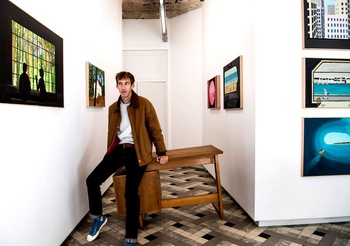
© Saskia Vanderstichele
They feel very intimate.
JEAN JULLIEN: Yeah, for me they definitely are. I like to put places into my paintings that are dear to my heart, like the beach, Brittany, places I have been to while travelling, like Broad Beach in Malibu or a cabin in Northern California. And this place, La Grière, very near La Rochelle, where my parents live, where you can find the art deco house with the yellow shutter that gave the show its title.
Every summer I go back to Brittany and fill sketchbooks of paintings at the beach. The rocks with lichen, this grey mass with fluorescent green or orange, I find that visually very exciting. Whenever I see it somewhere, it’s like Proust’s madeleine: an explosion of meaning.
Is your art a way of dealing with reality?
JULLIEN: Absolutely. But there is no drama in my way of dealing with things. My work comes from a happy place. When I paint, it’s because there is something I have enjoyed and want to remember. My paintings are like graphic postcards. Not in the sense that they’re an accurate rendition of reality, but that they’re an accurate rendition of the moment.
Do you find it easy to get personal in your work?
JULLIEN: They are places for which I have a personal affection, but in the paintings I mix them all up. The restaurant scene, for example, blends the interior of a bistro in California with a street scene in Brittany. I mix memories together, so perhaps the personal aspect is hidden from other people. They are all scenes that you see through a frame – a tunnel wave, a car window, Venetian blinds, a cabin in the woods. Like a sort of window into something. That suggestiveness is something that I’m quite attached to.
And I don’t feel like I’m pouring out deep wounds. I’m not telling the story of my relationship with my mother. I wouldn’t know how, I have a great relationship with her. [Laughs] Actually, she’s in a lot of my work. Ever since I’ve known her, she’s always had the same haircut. It’s this simple shape, and because of the way I approach communication and graphic art – through minimal symbols – she’s the perfect Playmobil to put in the scenes.
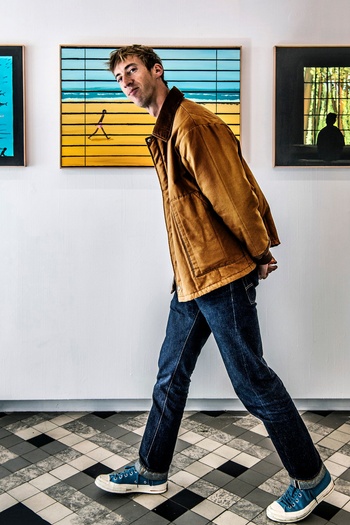
© Saskia Vanderstichele
You have built a reputation with your drawings. Does painting change things?
JULLIEN: There is obviously the excitement of novelty, of being free in a new playground. And it does change things, yes. In my drawings, most of the time I would focus on characters and a minimal array of elements, because I didn’t have the skill to do realistic mountain scenes. With painting I find myself more comfortable suggesting environments. Big faces never worked in my paintings, because it was me trying to reproduce in painting what I used to do with drawing. I can do visual jokes or puns with way less elements in a drawing. That’s why I started drawing smaller characters and putting them in suggestive environments.
the margin of error
“Drawing is more like communicating an idea,” Jean Jullien continues. “There was nothing personal about what I was producing. Obviously, I did mean a lot of things sincerely, but it wasn’t my story. Painting does give me that possibility. And in a way, it’s also nice not to have the immediacy that I’ve been used to. When you do a joke in a drawing, if it is successful, everybody gets it, and that is the end of it.”
That’s all too modest. Jean Jullien’s drawings sometimes feel as familiar as the relativizing jokes, advice, or comfort that you might receive from close friends. “Still, I’m constantly disappointed by what I do. But from quite early on I have accepted my limitations and appropriated the little that I had, and that was my visual language. To me, it’s more about practicality, being able to express ideas, no matter the application. When I draw, it usually stems from a situation that I encounter, something that bugs me, and that I’m obsessing over, and then it becomes a mass, that I try to synthesize. Like a big balloon of problems that you try to pierce. No matter the intricate complexity, the end will be this simple bit that I share.”
Drawing is a fitting medium in that respect. It’s very democratic.
JULLIEN: Yeah, completely! You can see that by the millions of people who share their drawings on social media these days. I think this naivety or poverty of skill is maybe the biggest leitmotif throughout my work, and what I enjoy most. I think that the fact that I’m not constantly fighting to better myself and become incredibly good at doing it is also why I’m so interested in the continuity of what I do. I don’t want to limit myself to one craft. I’m not a painter or an illustrator, I’m both.
Incorporating the possibility of flaws makes it livelier.
JULLIEN: Yeah, it’s nice to hear people say that, but most of the time when I show an image, I only think about what people might see as a flaw or mistake. You always anticipate the worst. [Laughs] But it’s true, there is a certain charm in the margin of error. It’s human.
There is no drama in my way of dealing with things. My work comes from a happy place
Do you ever fear being pigeonholed?
JULLIEN: Yeah. I know I am pigeonholed by some people. It’s nice to have people like Alice and Raf [the founders of Alice Gallery and the MIMA – KS] who appreciate you as a creative individual. Categorisation is a sort of cage. My instinct is like: “Oh, am I just that?”
How people label your work, well, it’s just a label. But I do sometimes find people’s expectations quite difficult. I’m a practicing illustrator, I have done commercial work since I was at school. That’s why it’s important for me to do exhibitions, make books and installations, and to have this sort of looseness of exploration and mistakes.
manic monday
It is this fallible, human side that makes Jean Jullien’s work so powerful. It is propelled by amazement and wonder. “I walk around and I’m like ‘Oh, this is so beautiful.’ I find a lot of things beautiful and I’m extremely easily stimulated. Yeah, massively. I mean, too much. [Laughs] I get distracted... I’m a very visual person. That is completely what makes me tick.” What follows is a kind of innocent and stubborn, childlike questioning of everything and everyone. “Like an honest question? Yeah, totally. It’s nice when you don’t necessarily try to make relatable work, when it’s just sincere observation, questioning, with a lot of naivety for sure, and then you see people’s reactions: ‘Ah totally, me too.’ It’s exactly that, for me it’s never an exclamation point, it’s either an open bracket or a question mark.”
Was there a moment when you realized that this simple thing you were doing struck a chord with other people?
JULLIEN: Yeah absolutely, but in a way that was also when I started thinking: “Am I on a loop?” I mean, social media can be really fun. If I feel tired on a Monday morning, I can do a drawing of me feeling tired on a Monday morning, and there will be 200 people relating to it. But it felt like I was repeating myself a bit. But in my sketchbooks, I had these things that made me really passionate. I associated drawing more with a daily practice, work, and painting as a leisurely mistake that was taking me away. So it felt like a change. But I still draw every day and my engagement with painting in no way implies a change of heart. It’s just one more path.
You need both?
JULLIEN: Yeah, definitely. And the painting stems from my drawing as well. The words “paintings”, “frames”, “canvasses” all bear such nobility, but in no way would I want to sound like “I’m moving from drawing to painting”. The two are interrelated. That’s what makes it a continuity of practice. I feel like I started with something so immediate and minimal that it’s like I’ve been trying to express myself with two Lego bricks, and now I’ve been given a new set.
> Jean Jullien: The Yellow Shutter. > 27/10, Encore, alicebxl.com
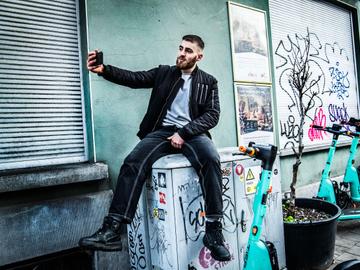
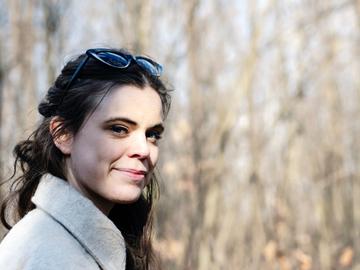
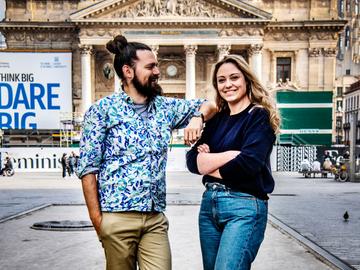

Fijn dat je wil reageren. Wie reageert, gaat akkoord met onze huisregels. Hoe reageren via Disqus? Een woordje uitleg.